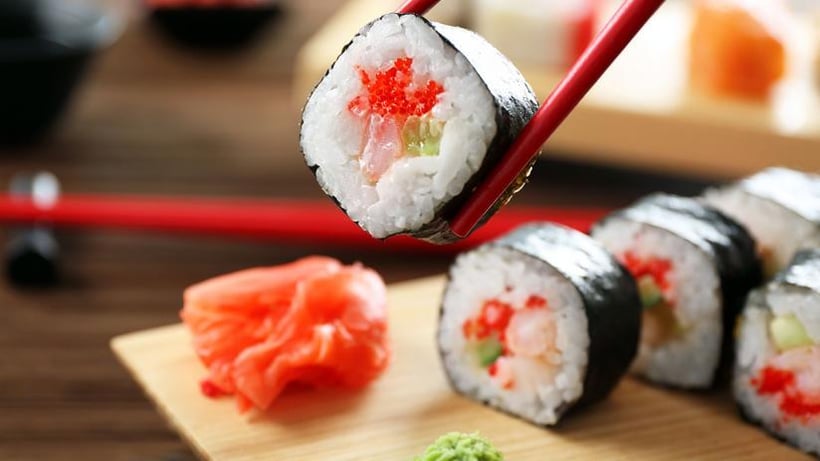
Sushi and sashimi have long been considered delicacies around the world, and with good reason — when done right, it can be a tasty, fresh and healthy meal or appetizer. Now, it’s not just established Asian restaurants serving raw fish; grocery stores often have sushi stalls, and you can even find sushi in places like airports or subway stations.
Because sushi and sashimi are high-risk foods, they need to be prepared extra carefully to ensure they’re safe to consume.
What are high-risk foods?
Sometimes called potentially hazardous foods, high-risk foods are those that are more likely to harbour harmful bacteria and disease-causing pathogens. These foods tend to be high in starch or protein, high in moisture and have neutral acidity (a pH over 4.5). Sushi has all these characteristics — not to mention, shellfish is a common allergen.
Bacteria thrive in temperatures of 5°C to 60°C, which is why this range is called the Temperature Danger Zone. Viruses and parasites can also be found in raw or undercooked meat and shellfish, so it’s crucial to take sushi safety seriously!
When prepared properly and under the right conditions, though, this delicacy can be enjoyable and safe for customers.
Purchasing and receiving sushi
The first step is buying the product. Only purchase from reputable suppliers, and be aware that refrigerated fish must be received at 5°C or below. Check for any signs that the fish has defrosted.
Damaged packaging can lead to contaminated foods, so make sure packaging has no rips or tears, and send it back to the supplier if you see these signs. Better safe than sorry!
The fish you’re receiving should:
- be firm and springy to the touch
- not have a “fishy” odour
Chilling, freezing and defrosting fish
Upon receiving fish, store it right away in the refrigerator at 5°C or below or in the freezer at -15°C or below. To prevent pathogens from growing, don’t let fish spend time in the Temperature Danger Zone.
Remember that:
- Fish that’s frozen for too long can become unsafe, and will need to be discarded
- You must store fish in airtight, labelled and dated containers
When it’s time to defrost the fish, do so in a refrigerator on the lowest shelf. Make sure you allot enough time, as this can take days, depending on the size of the fish. Once it has been defrosted fully, you need to use it that same day.
Never:
- defrost fish at room temperature
- refreeze fish that has already been defrosted
Preparing, handling and displaying sushi
The preparation stage requires care and close attention, as contamination leading to food-borne illness can happen easily when handling and preparing sushi.
Ensure anyone handling fish washes their hands thoroughly both before and after preparing the sushi. Clean and sanitise all surfaces — such as cutting boards, plates, knives and other utensils — before and after preparation. A couple of key things to keep in mind when it comes to preparation:
- Use batch preparation: This means only preparing the amount of sushi you need to fill the current order or request. Only take the amount of fish from the refrigerator that you need and can prepare in a short window of time. This makes it easier to ensure fish doesn’t spend time in the Temperature Danger Zone.
- Never rinse fish in a sink before preparation: When rinsing food in a sink, bacteria can splash onto other nearby surfaces.
Keep prepared sushi out of direct sunlight, and keep it refrigerated at 5°C or below. If it is displayed at 5°C, make sure the total time it spends at this temperature doesn’t exceed four hours. To prevent contamination, remember to keep displayed sushi in cabinets or covered plates.
Note that in New South Wales, businesses must keep records demonstrating adherence to time and temperature requirements when displaying sushi.
Accommodating vulnerable persons
Vulnerable populations are those who are at greatest risk of experiencing severe symptoms and reactions as a result of a food-borne illness. These groups include:
- children under 5 years old
- pregnant women and unborn children
- elderly people
- people with compromised immune systems
If your business plans to sell or serve a potentially hazardous food like sushi or sashimi, you need to be extra diligent about putting controls in place to reduce risk for these populations. Food Handlers need to take extra care to:
- properly thaw fish in the refrigerator rather than at room temperature
- prevent cross-contamination by using non-porous cutting boards and clean equipment and utensils before and after use
- wash hands thoroughly before and after handling different food types (such as raw and ready-to-eat foods)
- list all potential allergens on menus and properly label all ingredients
Safely handling and preparing sushi is essential for keeping your customers safe from food-borne illness, and having Food Handlers that are properly trained in safe food handling practices helps ensure that food safety standards are upheld. Learn more about the Australian Institute of Food Safety’s (AIFS) nationally recognised Food Safety Courses that helps food businesses across the country manage food safety risks and comply with food safety laws and requirements!




